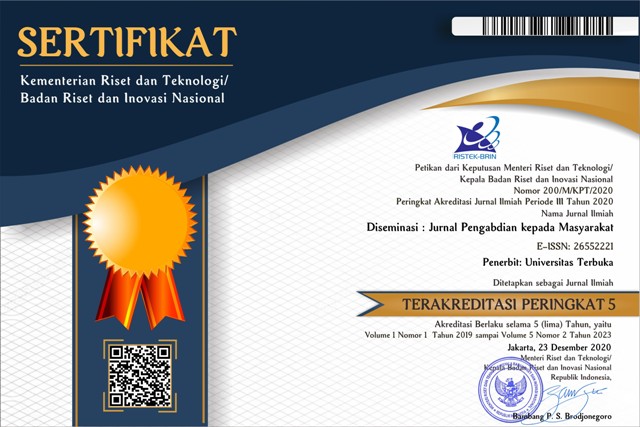PELATIHAN PEMBUATAN SABUN CUCI PIRING BERBAHAN ALAM DAUN PANDAN DI DESA REJO MULYO
DOI:
https://doi.org/10.33830/diseminasiabdimas.v6i1.7572Keywords:
Bahan alam, daun pandan, sabun cuci piringAbstract
Pemanfaatan bahan alami dalam pembuatan sabun cuci piring memiliki potensi yang sangat besar dalam meningkatkan perekonomian masyarakat. Sabun yang biasa digunakan untuk mencuci pada umumnya terbuat dari campuran alkali dan trigliserida dari asam lemak rantai karbon. Dalam proses pembuatan sabun pembusa yang umum digunakan adalah Sodium Lauryl Sulfate (SLS). Penggunaan SLS ini mengakibatkan terjadinya iritasi kulit baik itu iritasi kulit ringan maupun iritasi kulit berat. Dengan adanya bahan alami dalam proses pembuatan sabun cuci piring, formulasi yang dihasilkan bisa ramah lingkungan serta tidak mengandung bahan SLS. Salah satu bahan alami yang digunakan adalah daun pandan (Pandanus amaryllifolius) yang memiliki kandungan alami flavonoid, alkaloid, tanin, polifenol dan saponin. Kandungan yang terdapat dalam saponin pada daun pandan berfungsi untuk menghasilkan busa serta memiliki zat anti bakteri. Tujuan dari pelatihan ini adalah memberikan pembelajaran dalam memanfaatkan bahan alami pada proses pembuatan sabun cuci piring. Pada pelatihan ini melibatkan partisipasi aktif warga masyarakat Desa Rejo Mulyo, Kecamatan Pasir Sakti, Kabupaten Lampung Timur sehingga metode yang digunakan adalah metode participatory action research. Hasil akhir dari pelatihan ini diharapkan menjadi peluang usaha dan meningkatkan perekonimian masyarakat di Desa Rejo Mulyo, Kecamatan Pasir Sakti, Kabupaten Lampung Timur.
The use of natural ingredients in making dishwashing soap has enormous potential to improve the community's economy. Soap that is usually used for washing is generally made from a mixture of alkali and triglycerides from carbon chain fatty acids. In the process of making foaming soap, what is commonly used is Sodium Lauryl Sulfate (SLS). The use of SLS causes skin irritation, both mild skin irritation and severe skin irritation. By having natural ingredients in the process of making dishwashing soap, the resulting formulation is environmentally friendly and does not contain SLS. One of the natural ingredients used is pandan leaves (Pandanus amaryllifolius) which contain natural flavonoids, alkaloids, tannins, polyphenols and saponins. The saponin content in pandan leaves functions to produce foam and has anti-bacterial substances. The aim of this training is to provide learning in using natural ingredients in the process of making dishwashing soap. This training involved active participation from residents of Rejo Mulyo Village, Pasir Sakti District, East Lampung Regency, so the method used was participatory action research. It is hoped that the final result of this training will be business opportunities and improve the economy of the community in Rejo Mulyo Village, Pasir Sakti District, East Lampung Regency.The use of natural ingredients in making dishwashing soap has enormous potential to improve the community's economy. Soap that is usually used for washing is generally made from a mixture of alkali and triglycerides from carbon chain fatty acids. In the process of making foaming soap, what is commonly used is Sodium Lauryl Sulphate (SLS). The use of SLS causes skin irritation, both mild skin irritation and severe skin irritation. By having natural ingredients in the process of making dishwashing soap, the resulting formulation is environmentally friendly and does not contain SLS. One of the natural ingredients used is pandan leaves (Pandanus amaryllifolius), which contain natural flavonoids, alkaloids, tannins, polyphenols, and saponins. The saponin content in pandan leaves functions to produce foam and has anti-bacterial substances. The aim of this training is to provide knowledge about using natural ingredients in the process of making dishwashing soap. This training involved active participation from residents of Rejo Mulyo Village, Pasir Sakti District, East Lampung Regency, so the method used was participatory action research. It is hoped that the final result of this training will be business opportunities and improve the economy of the community in Rejo Mulyo Village, Pasir Sakti District, East Lampung Regency.
References
Adlina, S., Bachtiar, K. R., Nurhasanah, B., & Susanti. (2023). Formulasi dan Uji Aktivitas Sediaan Sabun Kertas Ekstrak Etanol Daun Pandan (Pandanus amaryllifolius) Sebagai Antibakteri. Pharmacoscript, 6(1), 22–30. https://doi.org/10.36423/pharmacoscript.v6i1.1126
Anggraeni, M., Mursal, Ii. L. P., & Frianto, D. (2022). Potensi Daun Pandan sebagai Pembuatan Sabun Cuci Piring non-SLS ECO-Friendly bagi Ibu Rumah Tangga di Desa Panyingkiran. Abdima Jurnal Pengabdian Mahasiswa, 2(1), 2711–2717.
Hamzah, F. H., Putra, D., Zalfiatri, Y., & Pramana, A. (2023). Physicochemical Characteristics and Anti-Bacterial Ability of Liquid Soap with the Addition of Pandan Wangi Extract. Industria: Jurnal Teknologi Dan Manajemen Agroindustri, 12(1), 25–35. https://doi.org/10.21776/ub.industria.2023.012.01.3
Mursyida, F., Febriani, H., & Rasyidah. (2021). Uji Efektivitas Antibakteri Ekstrak Daun Pandan Wangi (Pandanus amaryllifolius Roxb.) Terhadap Pertumbuhan BakteriStaphylococcus epidermidis. KLOROFIL: Jurnal Ilmu Biologi Dan Terapan, 5(2), 102–110. https://doi.org/10.30821/kfl:jibt.v5i2.10271
Setiawati, I., Oktarina, E., & Ariani, A. (2019). Kesesuaian Mutu Deterjen Cuci Air Untuk Alat Dapur. Prosiding PPIS, 135–142. https://ppis.bsn.go.id/downloads/2019/Kesesuaian Mutu Deterjen Cuci Cair untuk Alat Dapur.pdf
Downloads
Published
Issue
Section
License
Copyright and Licensing

Diseminasi : Jurnal Pengabdian kepada Masyarakat is licensed under a Creative Commons Attribution-NonCommercial-NoDerivativeWorks 4.0 International License. Allows users to copy and distribute the Article, provided this is not done for commercial purposes and further does not permit distribution of the Article if it is changed or edited in any way, and provided the user gives appropriate credit (with a link to the formal publication through the relevant DOI), provides a link to the license, and that the licensor is not represented as endorsing the use made of the work.















